Extended Near-Infrared Photoactivity of Bi6Fe1.9Co0.1Ti3O18 by Upconversion Nanoparticles
Abstract
1. Introduction
2. Experimental Section
2.1. Materials
2.2. Synthesis of BFCTONanoparticles with Various Morphologies
2.3. Preparation of PVP-Capped BFCTO Nanoparticles
2.4. Synthesis of Oleic-Capped and Free NGF Nanoparticles
2.5. Synthesis of BFCTO/NGF Samples
2.6. Photocatalytic Activities
2.7. Characterizations
3. Results and Discussion
4. Conclusions
Supplementary Materials
Author Contributions
Funding
Conflicts of Interest
References
- Wang, M.F.; Deng, K.R.; Lu, W.; Deng, X.R.; Li, K.; Shi, Y.S.; Ding, B.B.; Cheng, Z.Y.; Xing, B.G.; Han, G.; et al. Rational Design of Multifunctional Fe@γ-Fe2O3@H-TiO2 Nanocomposites with Enhanced Magnetic and Photoconversion Effects for Wide Applications: From Photocatalysis to Imaging-Guided Photothermal Cancer Therapy. Adv. Mater. 2018, 30, 1706747. [Google Scholar] [CrossRef] [PubMed]
- Wang, W.N.; Huang, C.X.; Zhang, C.Y.; Zhao, M.L.; Zhang, J.; Chen, H.J.; Zha, Z.B.; Zhao, T.; Qian, H.S. Controlled synthesis of upconverting nanoparticles/ZnxCd1−xS yolk-shell nanoparticles for efficient photocatalysis driven by NIR light. Appl. Catal. B Environ. 2018, 224, 854–862. [Google Scholar] [CrossRef]
- Chen, S.H.; Xiao, Y.; Wang, Y.H.; Hu, Z.F.; Zhao, H.; Xie, W. A Facile Approach to Prepare Black TiO2 with Oxygen Vacancy for Enhancing Photocatalytic Activity. Nanomaterials 2018, 8, 245. [Google Scholar] [CrossRef] [PubMed]
- Tian, L.Y.; Rui, Y.L.; Sun, K.L.; Cui, W.Q.; An, W.J. Surface Decoration of ZnWO4 Nanorods with Cu2O Nanoparticles to Build Heterostructure with Enhanced Photocatalysis. Nanomaterials 2018, 8, 33. [Google Scholar] [CrossRef] [PubMed]
- Fang, X.Z.; Shang, Q.C.; Wang, Y.; Jiao, L.; Yao, T.; Li, Y.F.; Zhang, Q.; Luo, Y.; Jiang, H.L. Single Pt Atoms Confined into a Metal-Organic Framework for Efficient Photocatalysis. Adv. Mater. 2018, 30. [Google Scholar] [CrossRef] [PubMed]
- Chen, C.; Ma, W.; Zhao, J. Semiconductor-mediated photodegradation of pollutants under visible-light irradiation. Chem. Soc. Rev. 2010, 39, 4206–4219. [Google Scholar] [CrossRef] [PubMed]
- Grabowska, E.; Diak, M.; Marchelek, M.; Zaleska, A. Decahedral TiO2 with exposed facets: Synthesis, properties, photoactivity and applications. Appl. Catal. B Environ. 2014, 156, 213–235. [Google Scholar] [CrossRef]
- Politano, A.; Cupolillo, A.; Di, P.G.; Arafat, H.A.; Chiarello, G.; Curcio, E. When plasmonics meets membrane technology. J. Phys. Condens. Matter. 2016, 28, 363003. [Google Scholar] [CrossRef] [PubMed]
- Agarwal, A.; Vitiello, M.S.; Viti, L.; Cupolillo, A.; Politano, A. Plasmonics with two-dimensional semiconductors: From basic research to technological applications. Nanoscale 2018, 10, 8938–8946. [Google Scholar] [CrossRef] [PubMed]
- Boukhvalov, D.W.; GÜrbulak, B.; Duman, S.; Wang, L.; Politano, A.; Caputi, L.S.; Chiarello, G.; Cupolillo, A. The Advent of Indium Selenide: Synthesis, Electronic Properties, Ambient Stability and Applications. Nanomaterials 2017, 7, 372. [Google Scholar] [CrossRef] [PubMed]
- Zhang, Y.; Schultz, A.M.; Li, L.; Chien, H.; Salvador, P.A.; Rohrer, G.S. Combinatorial substrate epitaxy: A high-throughput method for determining phase and orientation relationships and its application to BiFeO3/TiO2 heterostructures. Acta Mater. 2012, 60, 6486–6493. [Google Scholar] [CrossRef]
- Wei, Z.; Ying, L.; Wei, Z.B.; Yang, S.G.; He, H.; Cheng, S. Fabrication of a novel p–n heterojunction photocatalyst n-BiVO4@p-MoS2 with core–shell structure and its excellent visible-light photocatalytic reduction and oxidation activities. Appl. Catal. B Environ. 2016, 185, 242–252. [Google Scholar]
- Li, J.P.; Zhang, X.; Ai, Z.H.; Jia, F.L.; Zhang, L.Z.; Lin, J. Efficient Visible Light Degradation of Rhodamine B by a Photo-Electrochemical Process Based on a Bi2WO6 Nanoplate Film Electrode. J. Phys. Chem. C 2007, 111, 6832–6836. [Google Scholar] [CrossRef]
- Ke, J.; Duan, X.G.; Luo, S.; Zhang, H.Y.; Sun, H.Q.; Liu, J.; Tade, M.; Wang, S.B. UV-assisted construction of 3D hierarchical rGO/Bi2MoO6 composites for enhanced photocatalytic water oxidation. Chem. Eng. J. 2017, 313, 1447–1453. [Google Scholar] [CrossRef]
- Liu, Y.Z.; Xu, J.; Wang, L.Q.; Zhang, H.Y.; Xu, P.; Duan, X.G.; Sun, H.Q.; Wang, S.B. Three-Dimensional BiOI/BiOX (X = Cl or Br) Nanohybrids for Enhanced Visible-Light Photocatalytic Activity. Nanomaterials 2017, 7, 64. [Google Scholar] [CrossRef] [PubMed]
- Tu, S.C.; Huang, H.W.; Zhang, T.R.; Zhang, Y.H. Controllable synthesis of multi-responsive ferroelectric layered perovskite-like Bi4Ti3O12: Photocatalysis and piezoelectric-catalysis and mechanism insight. Appl. Catal. B Environ. 2017, 219, 550–562. [Google Scholar] [CrossRef]
- Li, H.D.; Sang, Y.H.; Chang, S.J.; Huang, X.; Zhang, Y.; Yang, R.S.; Jiang, H.D.; Liu, H.; Wang, Z.L. Enhanced ferroelectric-nanocrystal-based hybrid photocatalysis by ultrasonic-wave-generated piezophototronic effect. Nano Lett. 2015, 15, 2372–2379. [Google Scholar] [CrossRef] [PubMed]
- Chen, T.; Li, Z.A.; Chen, J.F.; Ge, W.; Liu, M.; Lu, Y.L. Hydrothermal synthesis and formation mechanism of Aurivillius Bi5Fe0.9Co0.1Ti3O15 nanosheets. CrystEngComm 2016, 18, 7449–7456. [Google Scholar] [CrossRef]
- Wang, J.L.; Li, L.; Peng, R.R.; Fu, Z.P.; Liu, M.; Lu, Y.L. Structural Evolution and Multiferroics in Sr-Doped Bi7Fe1.5Co1.5Ti3O21 Ceramics. J. Am. Ceram. Soc. 2015, 98, 1528–1535. [Google Scholar] [CrossRef]
- Li, Z.A.; Chen, T.; Chen, J.F.; Sun, D.J.; Liu, M.; Lu, Y.L. Morphology control of Aurivillius Bi11Fe3Ti6O33nanoparticles: Critical role of OH- concentration and citrate acid. CrystEngComm 2017, 19, 7001–7008. [Google Scholar] [CrossRef]
- Lei, Z.W.; Liu, M.; Ge, W.; Lin, Y.H.; Huang, Y.; Peng, R.R.; Lu, Y.L. Multiferroic properties of Bi7−xLaxFe1.5Co1.5Ti3O21 aurivillius phase ceramics prepared by hot press sintering method. J. Alloys Compd. 2014, 600, 168–171. [Google Scholar] [CrossRef]
- Chen, T.; Meng, D.C.; Li, Z.A.; Chen, J.F.; Lei, Z.W.; Ge, W.; Sun, S.J.; Sun, D.J.; Liu, M.; Lu, Y.L. Intrinsic multiferroics in an individual single-crystalline Bi5Fe0.9Co0.1Ti3O15 nanoplate. Nanoscale 2017, 9, 15291–15297. [Google Scholar] [CrossRef] [PubMed]
- Liu, Z.; Chen, F.T.; Gao, Y.P.; Liu, Y.; Fang, P.F.; Wang, S.J. A novel synthetic route for magnetically retrievable Bi2WO6 hierarchical microspheres with enhanced visible photocatalytic performance. J. Mater. Chem. A 2013, 1, 7027–7030. [Google Scholar] [CrossRef]
- Sun, S.M.; Wang, W.Z.; Xu, H.L.; Zhou, L.; Shang, M.; Zhang, L. Bi5FeTi3O15 Hierarchical Microflowers: Hydrothermal Synthesis, Growth Mechanism, and Associated Visible-Light-Driven Photocatalysis. J. Phys. Chem. C 2008, 112, 17835–17843. [Google Scholar] [CrossRef]
- Naresh, G.; Mandal, T.K. Excellent Sun-Light-Driven Photocatalytic Activity by Aurivillius Layered Perovskites, Bi5-xLaxTi3FeO15 (x = 1, 2). ACS Appl. Mater. Interfaces 2014, 6, 21000–21010. [Google Scholar] [CrossRef] [PubMed]
- Ge, W.; Fu, Z.P.; Li, X.N.; Wang, J.L.; Zhu, Z.; Liu, M.; Peng, R.R.; Lu, Y.L. Optimizing the photocatalysis in ferromagnetic Bi6Fe1.9Co0.1Ti3O18 nanocrystal by morphology control. RSC Adv. 2015, 5, 54165–54170. [Google Scholar] [CrossRef]
- Li, X.N.; Ju, Z.; Li, F.; Huang, Y.; Xie, Y.M.; Fu, Z.P.; Knize, R.J.; Lu, Y.L. Visible light responsive Bi7Fe3Ti3O21nanoshelfphotocatalysts with ferroelectricity and ferromagnetism. J. Mater. Chem. A 2014, 2, 13366–13372. [Google Scholar] [CrossRef]
- Ge, W.; Zhang, X.R.; Liu, M.; Lei, Z.W.; Lu, Y.L. Distance dependence of gold-enhanced upconversion luminescence in Au/SiO2/Y2O3:Yb3+, Er3+ nanoparticles. Theranostics 2013, 3, 282–288. [Google Scholar] [CrossRef] [PubMed]
- Ge, W.; Li, Z.A.; Lei, Z.W.; Chen, T.; Fu, Z.P.; Peng, R.R.; Liu, M.; Lu, Y.L. The synthesis of hexagonal phase Gd2O2CO3:Yb3+,Er3+ upconversion nanoparticles via SiO2 coating and Nd3+ doping. CrystEngComm 2015, 17, 5702–5709. [Google Scholar] [CrossRef]
- Liu, Y.J.; Lu, Y.Q.; Yang, X.S.; Zheng, X.L.; Wen, S.H.; Wang, F.; Vidal, X.; Zhao, J.B.; Liu, D.M.; Zhou, Z.G.; et al. Amplified stimulated emission in upconversion nanoparticles for super-resolution nanoscopy. Nature 2017, 543, 229–233. [Google Scholar] [CrossRef] [PubMed]
- Chen, S.; Weitemier, A.Z.; Zeng, X.; He, L.M.; Wang, X.Y.; Tao, Y.Q.; Huang, A.J.Y.; Hashimotodani, Y.; Kano, M.; Iwasaki, H.; et al. Near-infrared deep brain stimulation via upconversion nanoparticle–mediated optogenetics. Science 2018, 359, 679–684. [Google Scholar] [CrossRef] [PubMed]
- Dawson, P.; Romanowski, M. Excitation Modulation of Upconversion Nanoparticles for Switch-like Control of Ultraviolet Luminescence. J. Am. Chem. Soc. 2018, 140, 5714–5718. [Google Scholar] [CrossRef] [PubMed]
- Politano, A.; Viti, L.; Vitiello, M.S. Optoelectronic devices, plasmonics, and photonics with topological insulators. APL Mater. 2017, 5, 035504. [Google Scholar] [CrossRef]
- Sun, L.D.; Wang, Y.F.; Yan, C.H. Paradigms and Challenges for Bioapplication of Rare Earth Upconversion Luminescent Nanoparticles: Small Size and Tunable Emission/Excitation Spectra. Acc. Chem. Res. 2014, 47, 1001–1009. [Google Scholar] [CrossRef] [PubMed]
- Wang, F.; Liu, X.G. Multicolor tuning of lanthanide-doped nanoparticles by single wavelength excitation. Acc. Chem. Res. 2014, 47, 1378–1385. [Google Scholar] [CrossRef] [PubMed]
- Auzel, F. Upconversion and anti-Stokes processes with f and d ions in solids. Chem. Rev. 2004, 104, 139–173. [Google Scholar] [CrossRef] [PubMed]
- Chen, G.; Qiu, H.; Prasad, P.N.; Chen, X. Upconversion nanoparticles: Design, nanochemistry, and applications in theranostics. Chem. Rev. 2014, 114, 5161–5214. [Google Scholar] [CrossRef] [PubMed]
- Wang, W.; Huang, W.; Ni, Y.; Lu, C.; Xu, Z. Different upconversion properties of β-NaYF4:Yb3+,Tm3+/Er3+ in affecting the near-infrared-driven photocatalytic activity of high-reactiveTiO2. ACS Appl. Mater. Interfaces 2014, 6, 340–348. [Google Scholar] [CrossRef] [PubMed]
- Wang, J.L.; Fu, Z.P.; Peng, R.R.; Liu, M.; Sun, S.J.; Huang, H.L.; Li, L.; Knize, R.J.; Lu, Y.L. Low magnetic field response single-phase multiferroics under high temperature. Mater. Horiz. 2015, 2, 232–236. [Google Scholar] [CrossRef]
- Meng, F.X.; Liu, S.; Wang, Y.F.; Tao, C.; Xu, P.; Guo, W.B.; Shen, L.; Zhang, X.D.; Ruan, S.P. Open-circuit voltage enhancement of inverted polymer bulk heterojunction solar cells by doping NaYF4 nanoparticles/PVP composites. J. Mater. Chem. 2012, 22, 22382–22386. [Google Scholar] [CrossRef]
- Bogdan, N.; Vetrone, F.; Ozin, G.A.; Capobianco, J.A. Synthesis of ligand-free colloidally stable water dispersible brightly luminescent lanthanide-doped upconverting nanoparticles. Nano Lett. 2011, 11, 835–840. [Google Scholar] [CrossRef] [PubMed]
- Wang, F.; Deng, R.R.; Wang, J.; Wang, Q.X.; Han, Y.; Zhu, H.M.; Chen, X.Y.; Liu, X.G. Tuning upconversion through energy migration in core-shell nanoparticles. Nat. Mater. 2011, 10, 968–973. [Google Scholar] [CrossRef] [PubMed]
- Hou, D.; Luo, W.; Huang, Y.; Yu, J.C.; Hu, X. Synthesis of porous Bi4Ti3O12 nanofibers by electrospinning and their enhanced visible-light-driven photocatalytic properties. Nanoscale 2013, 5, 2028–2035. [Google Scholar] [CrossRef] [PubMed]
- Hou, D.F.; Hu, X.L.; Hu, P.; Zhang, W.; Zhang, M.F.; Huang, Y.H. Bi4Ti3O12 nanofibers-BiOInanosheets p-n junction: Facile synthesis and enhanced visible-light photocatalytic activity. Nanoscale 2013, 5, 9764–9772. [Google Scholar] [CrossRef] [PubMed]
- Ramasamy, P.; Chandra, P.; Rhee, S.W.; Kim, J. Enhanced upconversion luminescence in NaGdF4:Yb,Er nanocrystals by Fe3+ doping and their application in bioimaging. Nanoscale 2013, 5, 8711–8717. [Google Scholar] [CrossRef] [PubMed]
- Soderlind, F.; Pedersen, H.; Petoral, R.M., Jr.; Kall, P.O.; Uvdal, K. Synthesis and characterisation of Gd2O3 nanocrystals functionalised by organic acids. J. Colloid Interfaces Sci. 2005, 288, 140–148. [Google Scholar] [CrossRef] [PubMed]
- Yan, G.L.; Chen, J.; Hua, Z.Z. Roles of H2O2 and OH∙ radical in bactericidal action of immobilized TiO2 thin-film reactor: An ESR study. J. Photochem. Photobiol. A 2009, 207, 153–159. [Google Scholar] [CrossRef]
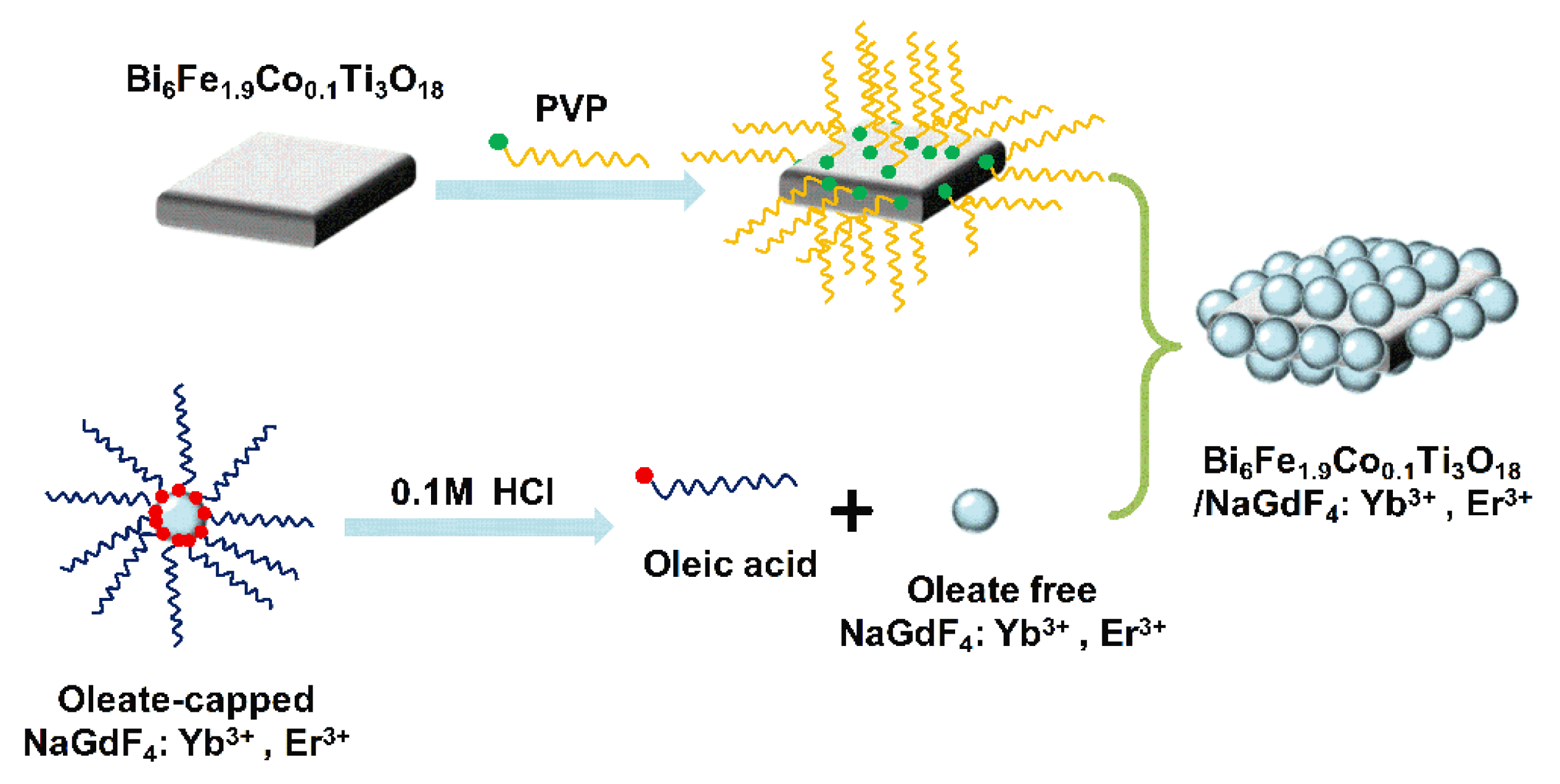

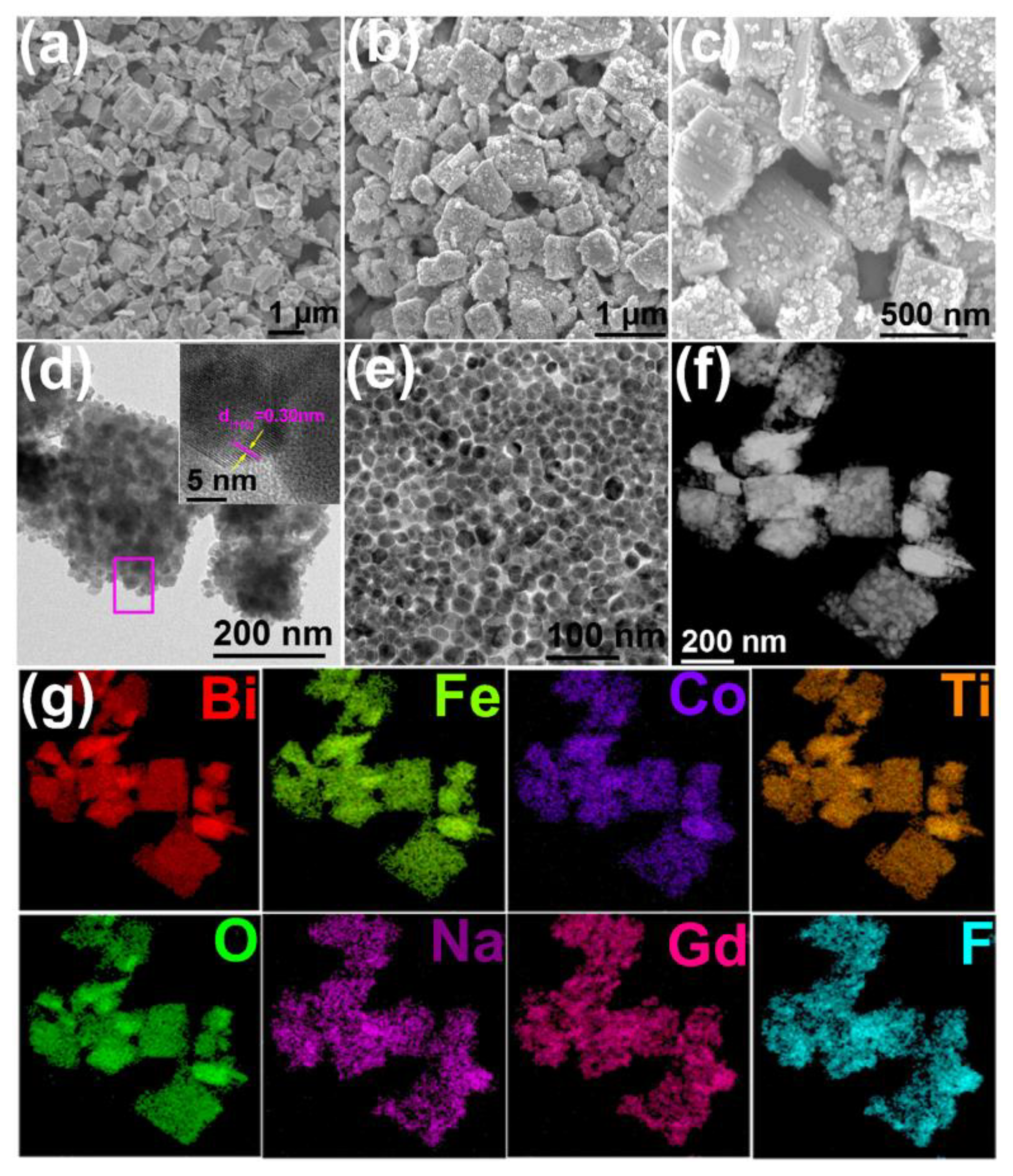

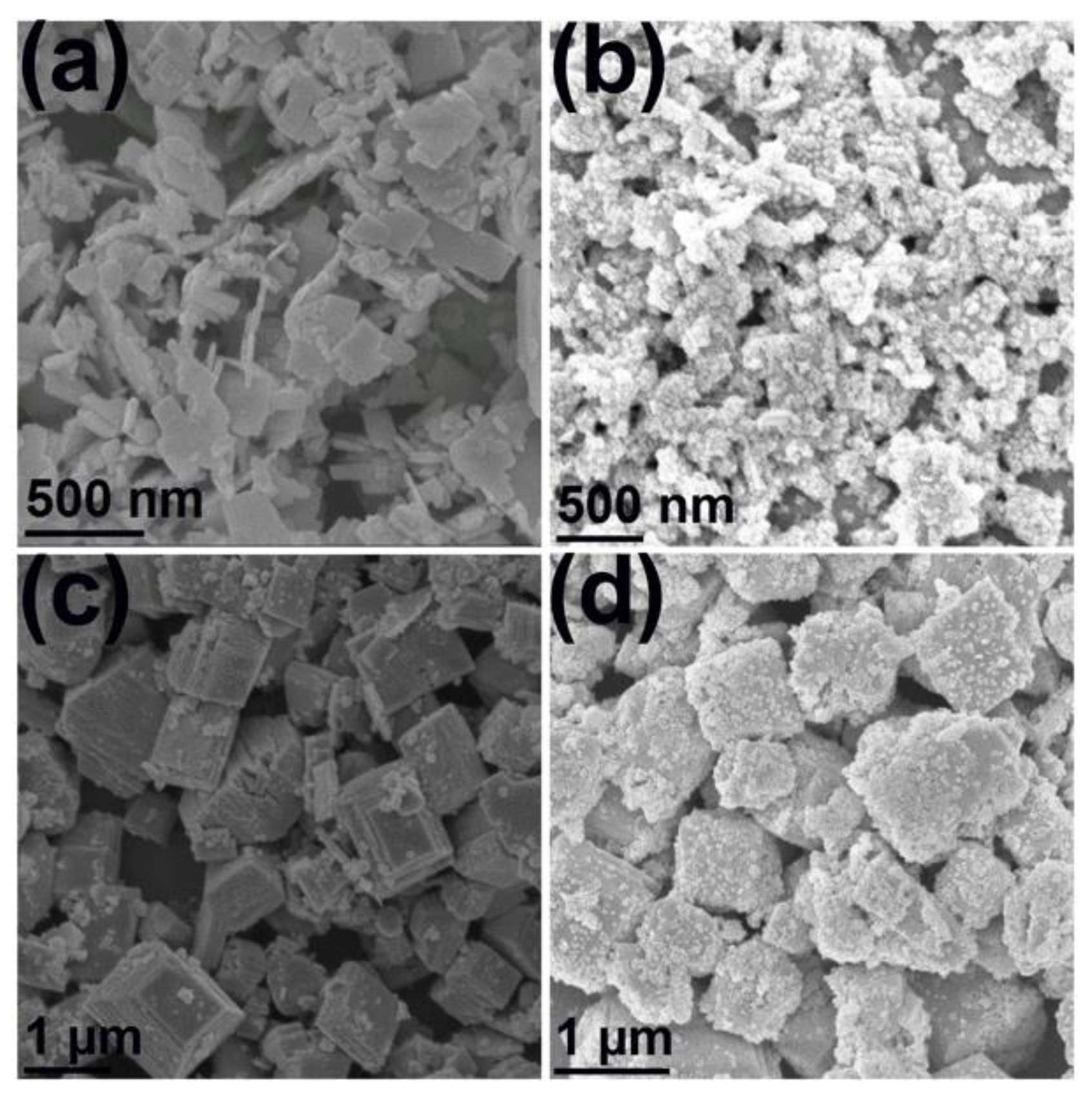
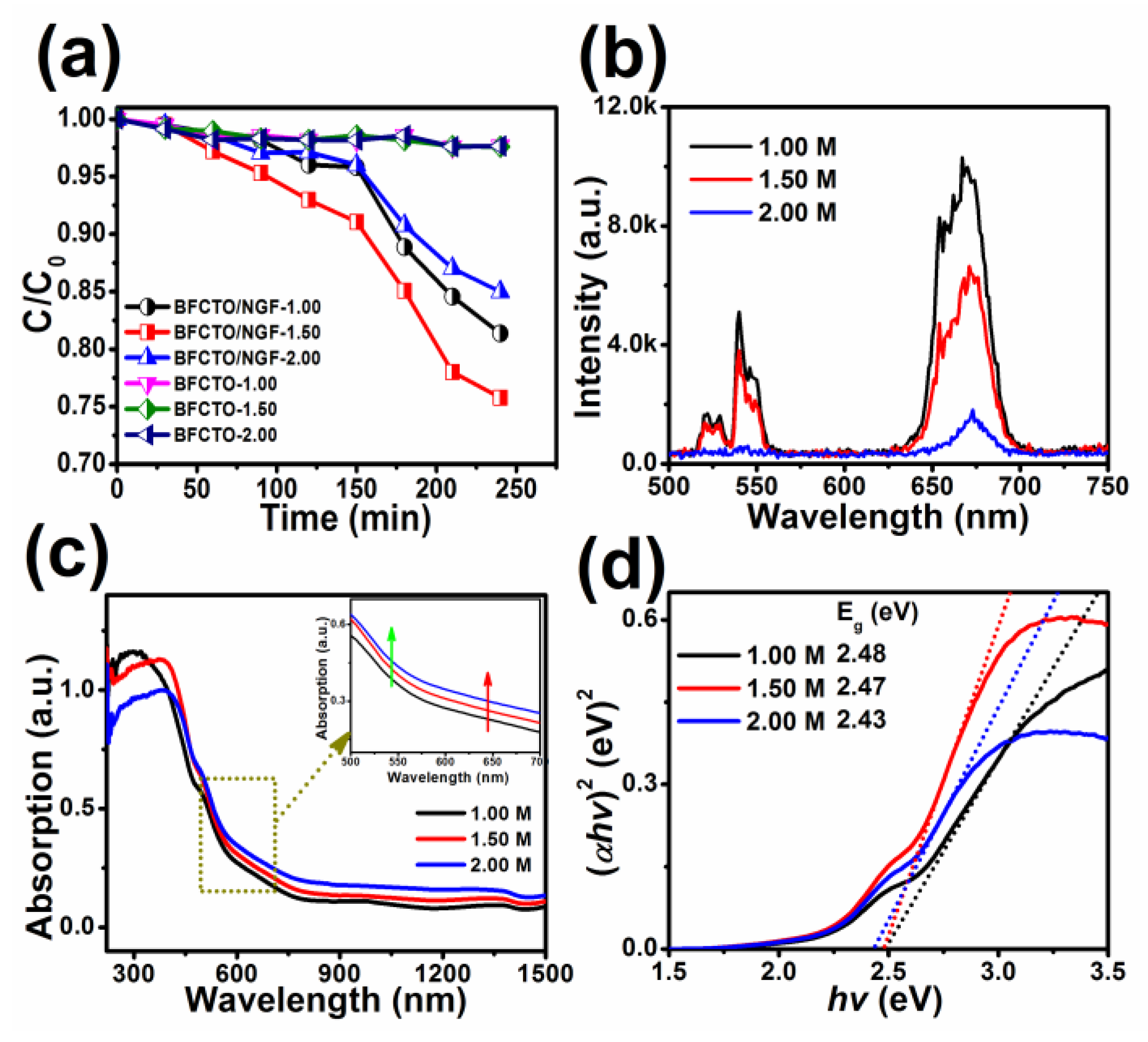
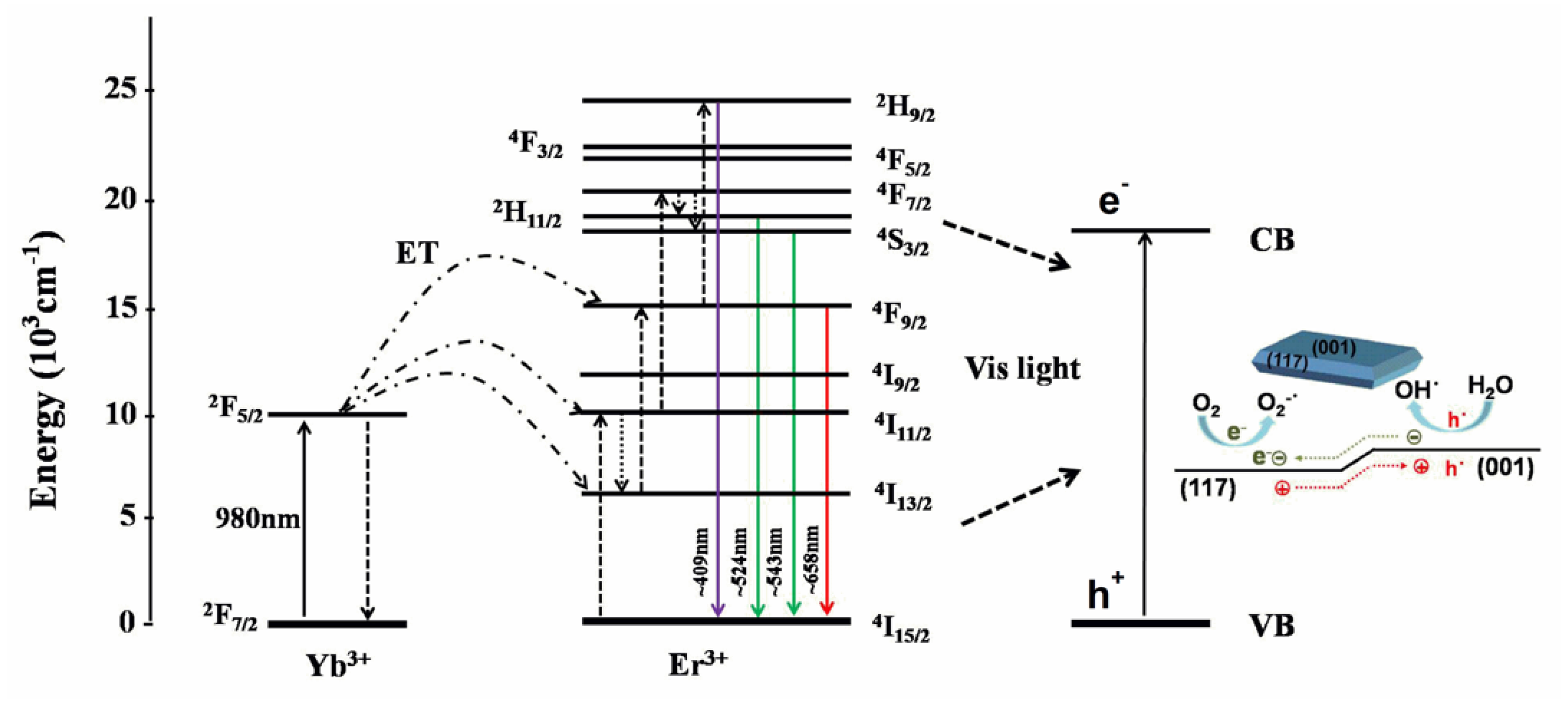
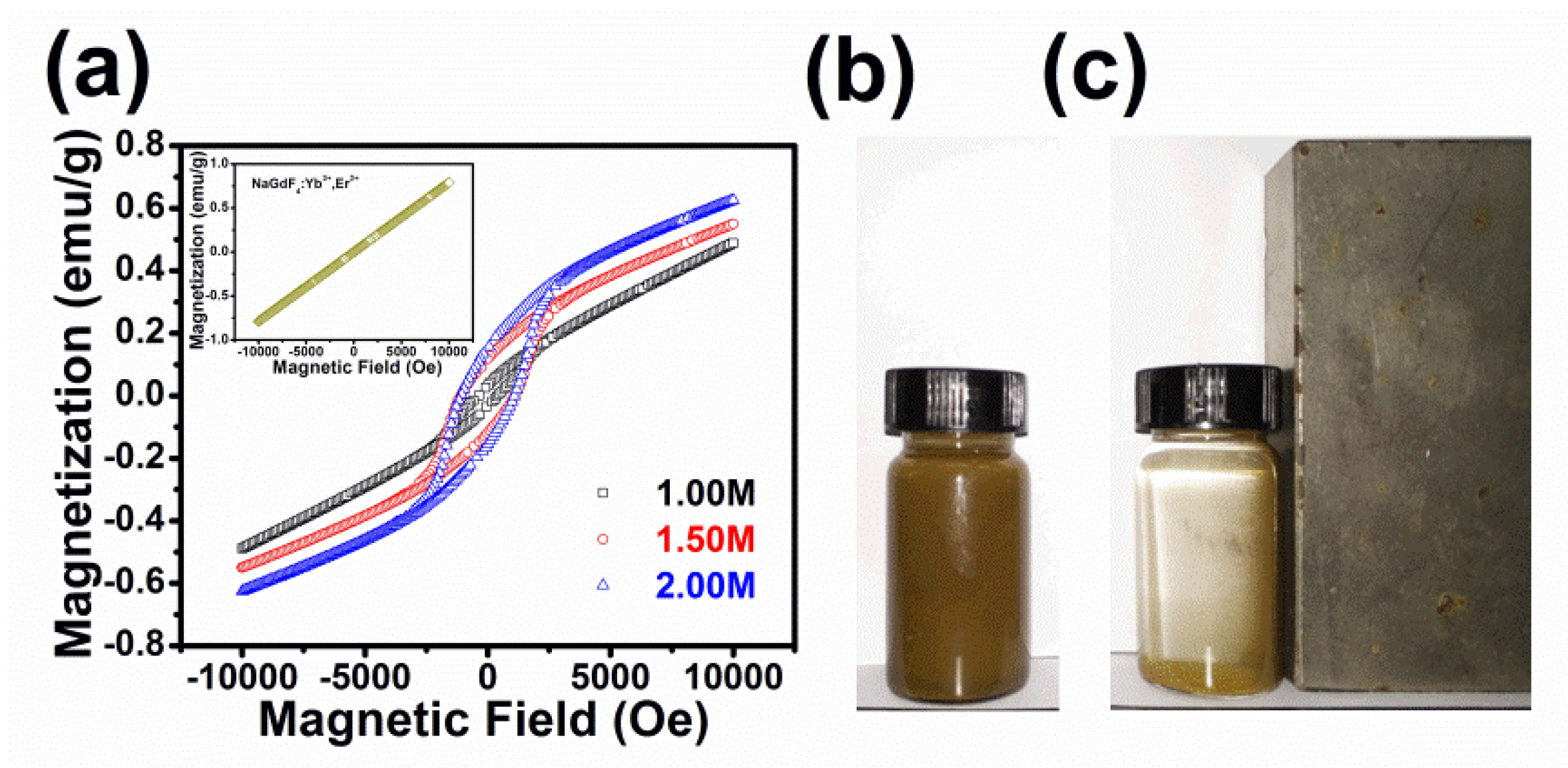
© 2018 by the authors. Licensee MDPI, Basel, Switzerland. This article is an open access article distributed under the terms and conditions of the Creative Commons Attribution (CC BY) license (http://creativecommons.org/licenses/by/4.0/).
Share and Cite
Ge, W.; Li, Z.; Chen, T.; Liu, M.; Lu, Y. Extended Near-Infrared Photoactivity of Bi6Fe1.9Co0.1Ti3O18 by Upconversion Nanoparticles. Nanomaterials 2018, 8, 534. https://doi.org/10.3390/nano8070534
Ge W, Li Z, Chen T, Liu M, Lu Y. Extended Near-Infrared Photoactivity of Bi6Fe1.9Co0.1Ti3O18 by Upconversion Nanoparticles. Nanomaterials. 2018; 8(7):534. https://doi.org/10.3390/nano8070534
Chicago/Turabian StyleGe, Wen, Zhiang Li, Tong Chen, Min Liu, and Yalin Lu. 2018. "Extended Near-Infrared Photoactivity of Bi6Fe1.9Co0.1Ti3O18 by Upconversion Nanoparticles" Nanomaterials 8, no. 7: 534. https://doi.org/10.3390/nano8070534
APA StyleGe, W., Li, Z., Chen, T., Liu, M., & Lu, Y. (2018). Extended Near-Infrared Photoactivity of Bi6Fe1.9Co0.1Ti3O18 by Upconversion Nanoparticles. Nanomaterials, 8(7), 534. https://doi.org/10.3390/nano8070534




